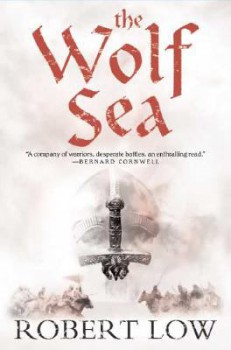Robert Low’s The Wolf Sea
 The Wolf Sea
The Wolf Sea
Robert Low
Thomas Dunne Books — St. Martin’s Press (340 pages, Hardback, June 2008, First published in Great Britain by HarperCollins, $24.95)
Reviewed by Bill Ward
This follow-up to 2007’s The Whale Road, Robert Low’s debut novel of grim Viking adventurers questing for the lost horde of Attila the Hun, is a continuation of the story of the Oathsworn and their new and untested leader, Orm Rurisksson. Orm, still a teenager, earned a reputation as a ‘deep thinker’ amongst his Viking crew and was their choice for leader with the death of Einar the Black — the man who had led them on a doomed expedition to the very ends of the earth in the first book of this series.
The Wolf Sea begins in Miklagard — the Norse-termed ‘Great City’ of Constantinople — with the theft of the jeweled saber Orm rescued from the Volsung horde in The Whale Road. Valuable in and of itself, perhaps even magical, the saber is also the key to finding Attila’s silver because Orm has carved its hilt with runes that will act as a guide should the Oathsworn ever return to the steppe. It turns out the saber has fallen into the hands of their old enemy, Starkad, who also seeks the fabulous treasure but has no idea that he possesses the key to finding it. Starkad is convinced that Martin, the venal priest that journeyed with the Oathsworn in their quest for Attila’s tomb, knows the way to the treasure and he sets off to the Holy Land to find him — with Orm and the Oathsworn in pursuit.
_____________
Thus begins an epic chase through the Mediterranean and Levant — or The Middle Sea and Jorsuland as seen through a Viking lens — a tempestuous, polyglot world rendered both exotic and knowable by Low’s richly detailed narrative. The 10th century was a fascinating period in the Near East, with a resurgent Byzantine Empire pushing back against a decaying Arab Caliphate amongst a veritable storm of commingling peoples and cultures. Into this crucible the Norse found themselves highly prized as mercenaries and soldiers, as the fame of the Varangian Guard of the Later Roman Emperors’ attest.
From their destitute beginnings the Oathsworn soon taste real success under Orm’s clever leadership. A battle with Saracen pirates in the Aegean brings them arms and treasure, and a deal with the Byzantine officials of Cyprus swells their ranks with captured Danes and gains them a new longboat, or hafskip, which they promptly rename the Fjord Elk as that is the name always held by the Oathsworn’s ships. On the Levantine coast they meet more northern mercenaries, and learn that many of their old comrades have been sold into slavery and are in the region — a fact they are bound by oath to rectify. Orm’s crew even fights in a major battle in the vicinity of Antioch alongside a Byzantine force led by a future Emperor, and visits the city of Jerusalem itself and the ill-storied fortress of Masada.
All this adventure is underscored by Orm’s narrative. Low is phenomenal at bringing the world of the 10th century to life and, for lovers of historical fiction, his confident narrative voice and characterization will be seen as every bit as important as his mastery of details and terminology from this period. It is through Orm’s eyes, through the logic and emotion and cultural framework of his times, that we can see this world as more than a collection of historical types, but as a convincing and knit-together whole. Everything from Orm’s vocabulary and choice of metaphor, to his agonizing over the wyrd of his men and the implications of their Odin-oath to each other, lets the reader participate in this vibrant world rather than merely observe it.
The Wolf Sea is grim, as befits a Viking Saga, not only in its brutal depiction of violence but in the dark fate that looms over the proceedings. Just as the oath forms a dangerous bond for the men of the Oathsworn and hangs over everything they do, so too does the legacy of that oath-breaker, Einar the Black, shadow Orm’s thoughts as he learns the ruthless necessities of leadership and finds himself becoming more like the man he both loved and hated. Add in a little seidr black magic, betrayal and assassination, and the discovery by the Oathsworn of the horrible transformation into monsters of men once like themselves, and you have a recipe for a dark adventure novel made all the more real by its vivid historical underpinnings.
Robert Low’s Oathsworn books are quickly gaining a reputation as a series to watch, and continue with The White Raven (2009 – Reviewed in Black Gate #14) and The Prow Beast (2010).
This review originally appeared in slightly different form in Black Gate Magazine Issue 13.
__________
BILL WARD is a genre writer, editor, and blogger wanted across the Outer Colonies for crimes against the written word. His fiction has appeared in numerous magazines and anthologies, as well as gaming supplements and websites. He is a Contributing Editor and reviewer for Black Gate Magazine, and 423rd in line for the throne of Lost Lemuria. Read more at BILL’s blog, DEEP DOWN GENRE HOUND.
[…] projected four-volume series for Black Gate, and I’ve just posted my review for book two, The Wolf Sea, over at the […]
[…] of recent years. Starting with 2007’s The Whale Road and continuing with last year’s The Wolf Sea and Low’s newest release, The White Raven, these books offer a Viking adventure worthy of the […]